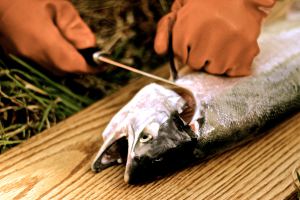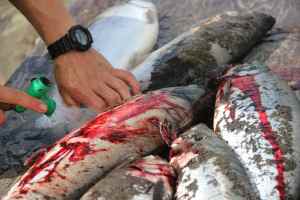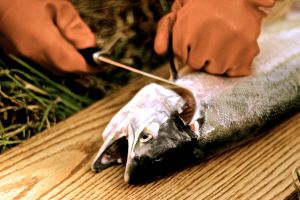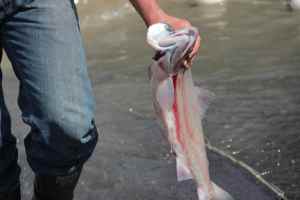Last month, to little fanfare, a thinktank called the Earth Policy Institute announced that humankind is on the verge of crossing a remarkable threshold: For the first time in history, we’ll soon be eating more farmed fish than wild-caught seafood.
American eaters are notoriously disconnected from our seafood’s origins, which is why McDonald’s can get away with offering a sandwich as nondescript as Filet-O-Fish (it’s Alaskan pollock, in case you were wondering) and seafood restaurants can cavalierly swap tilefish for red snapper. Still, even accounting for the fact that most farmed fish are grown in the black box that is China, I’m astounded by how quietly our diets have shifted, and by how anonymous most farmed seafood species remain.
We all know what cows and chickens look like, but can anyone reading this pick out a tilapia from a lineup? How many people have ever seen a salmon or shrimp farm? What the heck is barramundi? Branzino? Pangasius?
Though our eating habits are evolving rapidly, most consumers are flying blind. For every sophisticated pescatarian with a color-coded seafood card and a hankering for line-caught Pacific cod, there are a dozen other fish-eaters who buy what’s cheap and convenient — which is completely understandable when time is short and the kids are hungry. But this also means we’ve paid little attention to the ascent of aquaculture, even as it has overtaken our markets and groceries.
Of course, aquaculture’s rise is only half the story. The other half is that wild fisheries catches have been stagnant at about 90 million tons per year for the last three decades, even as worldwide fishing effort has increased. As the Earth Policy Institute report puts it, “The bottom line is that getting much more food from natural systems may not be possible.” Treating the ocean like a dumping ground for oil, plastic, and sewage probably hasn’t helped, either — just a hunch..
With the high seas unable to keep pace with escalating seafood demand, it’s no wonder that farmed fish has stepped into the breach.
But aquaculture’s takeover is problematic on many levels. Many fish farming operations are certifiable environmental disasters, none worse than salmon farms: all those crammed-in fish spread disease, produce waste like nobody’s business, and escape from their pens to compete and breed with wild fish, weakening their gene pool. And in what crazy world does it make sense to use five pounds of delicious, Omega-3-rich sardines to grow a single pound of pallid salmon meat?
Wild fish are a lot tastier and more diverse, too — if you live in the northeast, would you rather feast on a smorgasbord of swordfish, flounder, cod, croaker, tuna, porgy, mackerel and striper, or force down a hunk of tilapia every day for the rest of your life?
But farmed fish isn’t going anywhere, and it would be shortsighted to discount any potential source of protein on a planet that will soon be inhabited by 9 billion very hungry humans. What’s more, as aquaculture has matured, it’s also gotten cleaner. Raising fish in land-based tanks instead of ocean pens, feeding them vegetable matter instead of wild forage fish, and growing several species together in polycultures are just a few of the techniques through which aquaculture is expediting its own rise.
Still, in Alaska, where I’m living for the summer, singing the praises of farmed fish will get you shoved off the dock. I’ve seen the bumper sticker “Friends don’t let friends eat farmed salmon” more than once. Alaskans don’t hate farmed fish because of what aquaculture does to the environment — they hate farmed fish because of what aquaculture has done to fishermen.
In Bristol Bay, the distant corner of western Alaska that’s host to the world’s greatest sockeye salmon runs, fishermen told me repeatedly that the explosion of farmed salmon had proved disastrous for their business. There was a time, said Tom, a thirty-year industry veteran, that Bristol Bay’s fishermen got almost two dollars a pound for their catch — until cheap, low-quality farmed salmon hit the market and undercut their wares.
“2003 was the year it really hit rock bottom,” Tom told me, flipping through a well-worn journal in which he’d tabulated three decades of prices and catches. “We were probably getting forty cents a pound. Just about everybody in Bristol Bay was losing money.”
Fishermen aren’t the only ones to suffer when markets crash. Every fisherman is a small business: he (or she) employs two or three crewmen, and his boat helps prop up a vast, interconnected marine economy. The marine supply storeowner, the ice vendor, the fuel vendor, and dozens of other local entrepreneurs depend on the business of fishermen; without them, vibrant waterfronts degrade into ghostly, rotting pilings.
When the Canadian government shut down collapsed cod fisheries in Newfoundland and Labrador in 1992, for example, 10% of the population fled inland. The fish haven’t come back, and neither have the communities. And while fishermen often get blamed for facilitating their own demise through overfishing, they’re just responding to perverse government regulations and subsidies and the demands of global markets. Hate the game, not the player.
Fortunately, consumers are gradually learning to distinguish between the facsimile that is farmed salmon and the delicious, wild-caught, genuine article. Prices have rebounded: most of the fishermen I spoke with in Bristol Bay were getting somewhere between $1.30 and $1.50 per pound. That’s enough to keep salmon fishermen well in the black — although it makes you wonder exactly whom you’re enriching when you pay $19.99 per pound at a seafood counter.
These wild Alaskan sockeye salmon didn’t make it back to their home rivers to spawn, but never fear: Bristol Bay’s fisheries are some of the world’s most sustainable.
A Bristol Bay fisherman prepares to cut fillets from the first sockeye salmon of his season.
Not every sockeye salmon caught in Bristol Bay makes its way to market — after all, fishermen have to eat, too.
Ben Goldfarb is a freelance writer and the former editor of Sage Magazine. This is the first installment of Fish for Thought, a monthly column about the seafood we eat and the men and women who catch, grow, and harvest it for us.





Comments are closed.